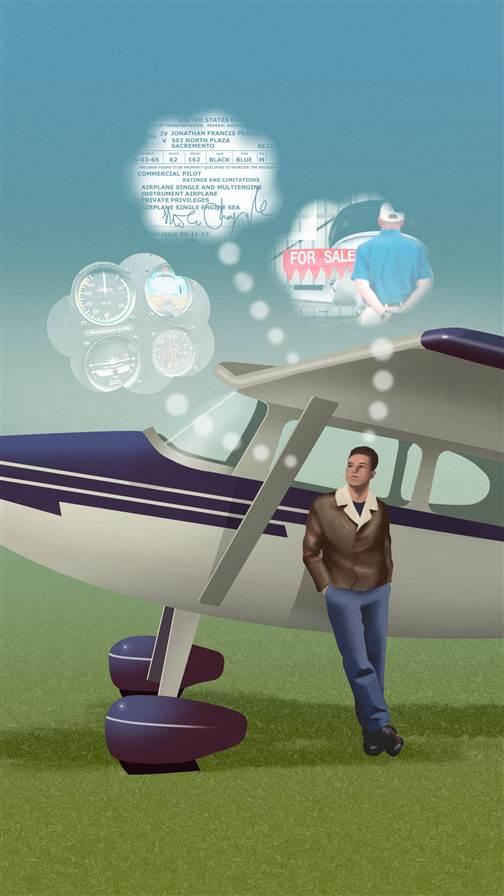Proficiency: Exiting the hold
Reaching your aviation goals
By Jolie Lucas
Fly for a minute, turn for a minute, fly for a minute, turn for a minute. In instrument flying you might be instructed to enter a hold if you cannot land because of weather below minimums, inbound traffic congestion, or runway unavailability. At some point you must assess whether landing at the intended destination airport is feasible or if flying to the alternate is more prudent.
 Much like flying an actual hold, there comes a time in every pilot’s career where an honest assessment of performance, desires, and goals needs to happen. Are you one of the many pilots stuck in the hold, unable to complete your aviation goals? Here are six keys to exiting a career holding pattern and reaching your goals.
Much like flying an actual hold, there comes a time in every pilot’s career where an honest assessment of performance, desires, and goals needs to happen. Are you one of the many pilots stuck in the hold, unable to complete your aviation goals? Here are six keys to exiting a career holding pattern and reaching your goals.
1. Maximize your timing
The two Greek words for the measurement of time are chronos and kairos. Chronos describes linear, chronological time such as minutes, hours, days, and years. For example, an 18-year-old earning a private pilot certificate and attending a university aviation program would expect to complete instrument, commercial, and certificated flight instructor in a certain number of months. Contrast that with kairos, meaning the indeterminate moment that is propitious for action, and this instant of time must be seized with great force. A decision based on kairos would be a gut feeling, or a chance opportunity that presents itself.
Many pilots stuck in the hold are waiting for the “right time” (chronos) to pursue their next rating, or feel like time has passed them by. However, they don’t realize that they can make a decision based on opportunity and effort (kairos). Time really is on your side. Take chances when they present themselves. Keep an open mind. Your history does not have to define your aviation destiny.
2. Choose your course of study wisely
Learners are as variable as the aircraft they fly. Set yourself up for success. A decision on the best course of study must take into account the following components:
- Quality of study program.
- Mode of study (in-person, online, self-study).
- Level of accountability (peer pressure, schedule, community).
- Value.
Are you choosing a professionally developed curriculum or planning to use a variety of books and study guides? Do you need the pressure of having a time-based weekly program, or are you self-motivated enough for home-based study? Whatever you choose, consider these factors to maximize your chance of success.
3. Let yourself be a flexible thinker
Breaking out of a cycle of inaction or inactivity requires action. As an adult, it sometimes is difficult to allow yourself to be a learner. Brain research in decades past pointed to brain development being completed in stages of childhood and remaining relatively fixed until death. However, in the late 1990s, research began to show evidence of neural plasticity, the idea that your brain isn’t completely hard-wired. Through experience and training, we can alter the brain’s functioning, forcing a cortical and neuronal rewiring.
Many pilots stuck in the hold are waiting for the “right time” to pursue their next rating. They don’t realize that they can make a decision based on opportunity and effort.Flexible thinking is key to getting out of a holding pattern. Through practice you will gain mastery. One achievement opens up the belief that you can do more. Learn from the best, let yourself make mistakes, give yourself grace, and marvel how education can change your brain.
4. Quiet the critic
Most people’s critic gets up in the morning before them and goes to sleep after they do. It keeps a running commentary of everything you have done wrong all day. In order to master something new, you will have to first master your critic. This process must be quite active. Simply trying to ignore the critic will not work. Your brain and body cannot tell the difference between anxiety and excitement. The layer that makes that determination is thought. The thoughts you have about your journey will determine whether you perceive worry or anticipation. Breaking out of the hold requires inserting positivity into your thinking. If you make a mistake in training, ’fess up, analyze what went wrong, and move on.
5. Exhibit determination
Our greatest strength lies not in never having fallen, but in rising every time we fall. This adage rings true in pursuing your aviation goals. Instead of looking at obstacles as a brick wall, look at them as a picket fence. Develop the ability to look past the obstacle and realize there is success on the other side.
Demonstrate sheer determination and be willing to apply yourself in any situation that will allow you to continue to build time, complete training, and pursue advancement. Perseverance means striving for excellence and guards against complacency.
6. Utilize community connection
Isolation is the enemy of exiting the hold. In this digital age you would be remiss not to use built-in aviation community connections such as message boards, online forums, type-specific websites, and Facebook. Attend aviation events, large and small. Network with old-timers, mentors, and instructors. Utilize the support of friends and family.
It is possible to exit the holding pattern you have been flying. Acknowledge that you have been stuck, use community connections to decrease isolation, make informed choices about resources, and be determined to change your aviation future. Look at obstacles merely as challenges to overcome; in the end your flying will be safer and more enjoyable and you will be proud of your accomplishments.
Jolie Lucas is a Mooney owner, licensed psychotherapist, and instrument-rated pilot. She is an Opinion Leaders blogger for AOPA (https://blog.aopa.org).


